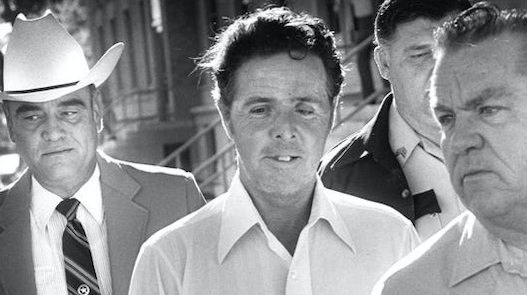
On October 31, 1979, a driver headed north on I-35 near Georgetown, Texas and noticed a body laying in between the highway and the nearby access road. Upon discovering the body, the driver drove to the nearest gas station where he called the Williamson County Sheriff’s Department. When the officials arrived, the body was discovered to be a young nude female, with the only item of clothing and physical evidence being a pair of orange socks. These orange socks would be the only identifier for the young female throughout her investigation.1
Henry Lee Lucas, a man neglected and abused by his mother at a young age, began his life of crime early on in his life. There wasn’t anything he had been charged and arrested for in the past that would amount to the vile acts he would confess to in future years, including confessing to the murder of the Orange Socks girl.2

Leading up to his confession, Lucas had been arrested for the possession of a firearm by a felon and taken to the Montague County Jail. While in custody, Lucas decided he would hand in a previously written statement that entailed the confessions to several murders.3 Within two days of his arrest in Montague County, he began confessing to slews of killings from all over the country. These confessions would, many years later, get him ultimately convicted of ten homicides, and he would be a very strong suspect in over one hundred other homicides.4 Lucas said that there were sixty murders he had added to his confession as a means to get back at the police for arresting him on the firearm charge, which he thought to be a charge made-up by the police. Although Lucas had confessed to many killings, it was his June 1983 confession to the Orange Socks murder that would get him convicted and lead him to become involved in the 1989 court case Lucas v. State of Texas.5
In 1989, the Lucas v State trial commenced, in which Lucas was tried for the murder and rape of the unidentified female in Williamson county, better known as the “orange socks girl.” During the court’s proceedings, psychiatrists, state witnesses, as well as Lucas were put on the stand to testify and be questioned. As the trial came to a close, the defense brought in an expert psychologist and psychiatrist to give their testimony regarding the evaluations they had previously conducted on Lucas. The expert psychologist Dr. Tom Kubiszyn conducted his psychological evaluations on February 28 and 29 of 1984, lasting about seven hours each, and from these evaluations Kubiszyn testified that Lucas, “has an IQ in the low average or normal range, with strong feelings of inadequacy and inferiority, of evasiveness and suspiciousness.”6 Kubiszyn also diagnosed Lucas as being schizophrenic while having some qualities of a sociopathic disorder. The expert psychiatrist Dr. Jay Fogelman had conducted five interviews with Lucas where he gained information from Lucas about himself. From these interviews Fogelman came to the same conclusion as Kubiszyn in that Lucas was suffering from some form of schizophrenia that needed treatment, as well as that he may have an antisocial personality. Both Kubiszyn and Fogelman said that Lucas was not only suffering from the previously mentioned schizophrenia, but that he was also a dangerous individual based on his history of previous violence.7
When the issue of his right to an attorney arose for Lucas, he tried to claim that he was denied his right to counsel guaranteed to him in the sixth amendment. But it was also noted that he did not go against the statements given by the state witnesses and understood that he would not receive counsel and did not want an attorney present. Later, against the advice of his various attorneys to remain silent and implement discretion, Lucas chose to do the opposite and he had appeared “…to have been determined to speak to the authorities desiring his attention. In what may be best termed a single-minded purpose, he appears to have rejected his right to remain silent and put the State to its burden of proving a particular crime…..appellant made what can only be termed a conscious practice of informing on himself as to crimes which, up until that point in time, remained unsolved.” In this same scenario, Lucas claimed he only wanted to talk about where the bodies were, as long as someone listened and was determined to only confess to his “criminal conduct” based on his desires and terms.8

As the trial continued, Lucas described the incident in his words. Lucas described the Jane Doe has having refused to engage in intercourse with him and of having tried to jump out of the moving vehicle. Lucas claimed she grabbed hold of the steering wheel, and that he grabbed her in a motion to try and stop her attempt to escape, while she fought against him. This action caused by the deceased was thought to Lucas as a sufficient reason to handle her in such a manner since it could’ve resulted in a car accident and in his own demise. The court did not find this evidence and information useful in the incident that the deceased was trying to provoke violence from Lucas or to incite him. Despite this information and the details coming solely from Lucas, who would’ve been present for the crime, the court did not find any information that corroborated that Lucas had any desire or intention to release Jane Doe alive. Based on this notion, it was derived that Lucas killed the deceased not based on the passion in the heat of the moment, but from careful calculation.9
Based on all the relevant information and testimony given by the state’s witnesses, expert psychiatrist and psychologists, as well as Lucas’ own testimony, the court reached a verdict in the Lucas v. State trial. The verdict reached was guilty on the capital murder charge on Lucas, and he was given a life sentence in prison for his crime. Being as Lucas was being convicted on a capital murder charge—the highest offense one can commit—meant that he was being sentenced to death and would be put on death row.10 Lucas was to serve out his sentence in a facility in Texas for the remaining time of his life.11
Going back to the years prior to his conviction, starting in 1983, around the time of his orange socks confession, Lucas had been interviewed by around 600 different law enforcement agencies. Through these interviews about open cases, police were gaining useful information, and cleared roughly 210 homicide cases. But since these case closures were directly attribute to Lucas, he began bragging about how he was the one getting cases close, not the law enforcement agencies.12 This combined attention and the fact that he believed he was exhibiting retribution against police on the “made-up” firearm charge, could’ve led to why he chose to confess to the orange socks murder and the hundreds of others.
Lucas remained on death row until 1998. At that time, the then-governor of Texas George W. Bush cited that there was a lack of evidence linking Lucas to the murder of the then unidentified “orange socks” woman other than his confession, and removed his death sentence. This was the only time governor Bush would allow such a situation to occur. Having his death sentence removed, but his life in prison sentence still intact, Lucas remained in prison until his death in 2001 from a heart attack.13

After significant investigation, interviews and verification through familial DNA testing, the unidentified woman, who was known as “Orange Socks,” was identified. In 2019, almost forty years after her brutal murder and rape, the individual was identified as being Debra Jackson, from Abilene, Texas, and she was only twenty-three years old at the time of her untimely death. It was believed that Jackson had left her home in 1977, two years prior to her interaction with Lucas, and was not initially reported missing by her family.14
- Lucas v. State, 791 S.W.2d 35 (Tex. Crim. App. 1989), 40. ↵
- Steven A. Egger, The Killers Among Us: An Examination of Serial Murder and Its Investigation (New Jersey: Prentice Hall, 1998), 169. ↵
- Lucas v. State, 791 S.W.2d 35 (Tex. Crim. App. 1989), 41. ↵
- Steven A. Egger, The Killers Among Us: An Examination of Serial Murder and Its Investigation (New Jersey: Prentice Hall, 1998), 11. ↵
- Gisli Gudjonsson PhD, “The making of a serial false confessor: The confessions of Henry Lee Lucas,” The Journal of Forensic Psychiatry, 10:2 (1999): 416-426, DOI: 10.1080/09585189908403693 418, 421. ↵
- Lucas v. State, 791 S.W.2d 35 (Tex. Crim. App. 1989), 43. ↵
- Lucas v. State, 791 S.W.2d 35 (Tex. Crim. App. 1989), 43. ↵
- Lucas v. State, 791 S.W.2d 35 (Tex. Crim. App. 1989), 49. ↵
- Lucas v. State, 791 S.W.2d 35 (Tex. Crim. App. 1989), 65. ↵
- Content Team. “Capital Murder – Definition, Examples, Meaning, Cases, and Sentences.” Legal Dictionary, (February 15, 2019). https://legaldictionary.net/capital-murder/. ↵
- Gajanan Mahita, “The Story Behind the Netflix Series ‘The Confession Killer,’” Time, (December 6, 2019). https://time.com/5745028/the-confession-killer-henry-lee-lucas-netflix/. ↵
- Steven A. Egger, The Killers Among Us: An Examination of Serial Murder and Its Investigation (New Jersey: Prentice Hall, 1998), 172, 207. ↵
- Gajanan Mahita, “The Story Behind the Netflix Series ‘The Confession Killer,'” Time, (December 6, 2019). https://time.com/5745028/the-confession-killer-henry-lee-lucas-netflix/. ↵
- Abigail Arredondo, “Who Was Debra Jackson, the ‘Orange Socks’ Cold Case Victim?” KVUE, (August 8, 2019). https://www.kvue.com/article/news/local/who-was-debra-jackson-the-orange-socks-cold-case-victim/269-e7073ddd-14a5-4221-b223-27ae29f7f2c7. ↵



63 comments
Yuliana Vasquez
I really like this article because you really started the article with a really interesting case, and then it lead him to confess to many other murders. Its surprising how he made the choice to confess to so much, but its also really sad because all of these girls were killed. Especially the girl ” orange socks” wasnt identified until years later and wasn’t reported missing
Kennedy Arcos
This was such an interesting article, I had never heard of this story until reading this. I found it really interesting how Lucas committed to all of these crimes. I also found it extremely sad how it took so long to identify “Orange Sock Girl” and how her family never reported her as missing. Another thing that shocked me was that George Bush was the person who removed Lucus’ death sentence. Great and informative article!
Shriji Lalji
A very enticing story. I wonder what made Lucas keep confessing to his crimes. It could be his mental state or some other motive. I was shocked that it took so long to identify the orange sock girl. Whether his mental state can be used as an excuse for so many murders, I do not know. However this issue arrises many times in murder cases and it is always interesting to see how the courts rule.
Eliane Castorena
This is such an interesting and creepy article! It is crazy to think that he committed all those murders without being caught, until he was arrested for possession of a fire arm. He definitely confessed to all those murders because he wanted all the attention from the media and the police. It is truly sad, however, to read that the Orange Socks girl was later identified and that she was only 23 years old and was never reported missing by her family.
Davis Nickle
I had never heard of this case until now and after reading this article I am shocked by the mental state of Lucas. He was obviously a monster who was mentally unstable and a danger to society, and I am honestly surprised that his death sentence was revoked. I was glad to read that his life sentence was maintained. Every time I read an article like this I am shocked by humanity’s capacity for cruelty and violence.
Berenice Alvarado
I cannot believe it took almost 40 years to name the victim, and if he confessed to the killing why isn’t that enough if he was crazy don’t you think that he would have been put in a mental hospital rather than jail. I also find it ridiculous how the family of this girl did not look for her after so many years. I really enjoyed reading this article and know to not judge a person by their looks. Because you never know if the person sitting next to you is a serial killer. Because just like Henry, many others look just as normal as any other human being.
Nelly Perez
I honestly could not imagine how it took so many years to finally name the victim who was killed by Lucas. Lucas had several mental illnesses after psychiatrists took an analysis on him and testified against Lucas. Lucas grew up in a bad home which caused him to be violent and antisocial. He was neglected and abused by his own mother growing up.
Estefanie Santiago Roman
This article is detailed on the confession of Lucas and also on the trial. I hadn’t heard of him before, but I thought it was very interesting how he first refused to have representation and later on claimed that he wanted representation. I also found it interesting how he decided to confess to his murders as a way to get back to the authorities, but it makes me wonder how many people he actually murdered since I’m sure some of his confessions probably were not true.
Lesley Martinez
This is such a shocking and intriguing story. I had never heard of Henry Lee Lucas. It’s not often that you hear a serial killer confesses his crimes. It’s so sad to read that the young female was identified as just the “orange socks girl” and I’m sure she’s not the only one that is classified in such a manner. I also had no idea that President George W. Bush removed his death sentence, even after Lucas had confessed to several homicides. For Lucas to claim that he did not kill the young female based on passion, but to prevent an accident is outrageous. These types of events and confessions should teach the public that mental health awareness is important. Great article!
Alondra Lozano
It is really interesting on how he confessed all those homicides and felt proud of that. People like him are truly crazy. What was most interesting was how the police would go to him to help solve those cases which were over 100 of them. Thank God that in today’s world, cases can be solved faster and people with those kind of mental illness can be taken care of.